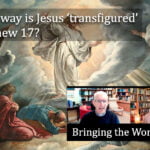 The lectionary gospel reading for Trinity 12 in Year A is Matthew 16.21–28, in which Jesus declares he is heading for Jerusalem to die, Peter rebukes him, and Jesus counter-rebukes Peter. It follows on from the strong commendation of Peter by Jesus after his confession at Caesarea Philippi, and offers a contrast with it at almost every point.
The lectionary gospel reading for Trinity 12 in Year A is Matthew 16.21–28, in which Jesus declares he is heading for Jerusalem to die, Peter rebukes him, and Jesus counter-rebukes Peter. It follows on from the strong commendation of Peter by Jesus after his confession at Caesarea Philippi, and offers a contrast with it at almost every point.
As we noted in relation to last week’s reading, for the first time in the Synoptic narrative, Jesus and his disciples now head south into hostile territory—though this cannot be a historical representation of his ministry, since he would have visited Jerusalem many times as a pilgrim.
The shadow of the cross the falls across this whole southward journey, as Jesus tries to get his disciples to understand the paradoxical and unwelcome nature of his mission (R T France, NIGTC, p 628)
The contrast between Galilee and the north, where Jesus has been mostly welcomed, and followed by large crowds, and the hostility of those in the south, corresponds with the contrast in the Fourth Gospel between the different meanings of ‘the world’. It is a place created through Jesus the Word, one which he loves and comes to rescue, but which also stands in enmity and opposition to him. (Note that, in the Synoptics, the welcoming crowd at Palm Sunday are pilgrims from the north, whereas the hostile crowd on Good Friday are local southerners.)
It is tempting to look for neat divisions and markers of structure in the text, and we have one here in the declaration of ‘From that time…’ which previously marked the end of John’s ministry as he was imprisoned and thus the beginning of Jesus’ in Matt 4.17. But though this passage begins the journey to the cross, it still has multiple connections with what immediately preceded it, and there continue to be glimpses of glory to which it is closely tied up, most obviously in the account of the Transfiguration that follows.
The parallels in Mark 8.31 and Luke 9.22 describe Jesus as ‘teaching’ and ‘saying’, and it is striking that Matthew uses the language of ‘showing’ (the verb deiknumi) which is unusual as a term for verbal communication (though note in Rev 1.1 that the ‘showing’ involves nearly half of what John writes as a record of what he hears; see also Acts 10.28 and 1 Cor 12.31). Although we are reading the story backwards, knowing how it is going to end, if (like the disciples) you had only read or experienced the first half of the gospel, this explicit teaching of Jesus would indeed come as a new revelation.
There is a strong sense in all three accounts of the ‘divine passive’: Jesus must go and must be killed and be raised; this is the divine plan and intention, rather than either being the choice of Jesus or the simple will of those involved—though the threefold agency of ‘elders, chief priests, and teachers of the law’ is spelled out carefully. Critical scholarship has consistently seen this kind of language in the gospels as the projection back of post-Easter faith onto the pre-Easter figure of Jesus. And yet there is plenty of precedent in the Old Testament for the idea of God’s chosen one experiencing rejection, suffering and death—in Psalms 22 and 69, both of which will be alluded to in Matthew’s passion account, in the portrait of God’s anointed one in Zech 9–14, taken up in Matt 21.4–5 and 27.9–10, and supremely in the description of the suffering servant in Isaiah 52.13–53.12 alluded to in Matt 20.28 and 26.28 (and already referred to in Matt 8.17).
The mention of being raised ‘on the third day’ is parallel to Mark 8.31 ‘after three days’; there is no contradiction here when we note the convention of counting ‘inclusively’, that is, including the first and last days in the numbering, a different convention from our own methods of counting.
The sharp exchange of rebuke and counter-rebuke between Jesus and Peter is both surprising and rather shocking, not least because of the praise lavished on Peter by Jesus just a few verses before. Although Peter is generally portrayed more positively in Matthew than in Mark, there is no holding back here. As previously, where Mark summarises Peter’s concern, Matthew records him as actually speaking in the strongest terms. Is there a sense here, I wonder, that Peter’s elevation by Jesus as ‘the rock’ has gone to his head, and he feels he can now decide what Jesus should and should not be doing? The idiomatic phrase hileos soi, ‘mercy to you’ is an abbreviation of the longer phrase ‘God have mercy on you!’ which we might colloquially translate as ‘God forbid!’ Peter clearly has a different idea of what God ‘must’ do in this situation. Ironically, the strength of Peter’s rebuke is paralleled by the later strength of his denial that he will ever betray Jesus in Matt 26.35—and we know what happened to that.
One moment, Peter is speaking the truth as revealed to him by his Heavenly Father; the next, he is leading Jesus astray under the influence of the father of lies! The language of ‘get behind me!’ isn’t merely a rebuke, since the phrase Jesus uses, opiso me, is the very language of discipleship that he then speaks to all the disciples (and in Mark 8.34, the crowds as well, who have disappeared from Matthew) ‘if anyone wishes to come after me’. Gundry comments:
Jesus tells Peter to go back to his position amongst the disciples where he belongs, following after Jesus, not taking him aside by walking ahead of him or at least beside him (cited in France, p 634).
We must surely read this along with the previous episode in understanding the qualifications around Peter’s distinctive position amongst the others and in the will of God for his people.
There is a curious contrast between Peter previously being a ‘rock’ and now becoming a ‘stumbling block’, not least because of the connection between the two similar terms as descriptions of Jesus by Peter in 1 Peter 2.4–8, citing Ps 118 and Is 8 and 28.
Whilst Peter’s rebuke to Jesus has been private, Jesus’ counter-rebuke appears to have been in the hearing of the disciples, and he now addresses them directly. The language of ‘taking up your cross’ must indeed have been startling to Jesus’ hearers, and it has lost its edge for us by being translated into the more anaemic terms of having some irksome burden to carry through life—which cannot possibly be what Jesus means. Its strangeness has again led critical scholarship to doubt its historicity; NT scholar James McGrath comments:
Taking up one’s cross certainly does not seem to have been an already-existing expression, nor is such a saying likely to have existed in that period. It seems as though it was only the reality of a crucifixion that could inspire such an idiom as in the case of Jesus and early Christianity. No one is likely to have used this horrific form of execution as a metaphor, just as we do not find “beheaded,” “put in the electric chair,” or “given a lethal injection” used metaphorically…
[A] historian will have to conclude that this saying is more likely to be a post-crucifixion invention than an authentic saying of the historical Jesus.
Against this, the one comment on the post suggests drily:
If Jesus actually said this, then it is possibly a case of him giving the answer to a question that no one had yet asked, namely, “What does it mean to follow a crucified Messiah?” When those who heard this saying, and perhaps thought it odd, crude, or awkward, months later heard that the same fellow had himself been crucified and was rumored to have been raised from the dead, they may have thought, “Hmm, didn’t he say something about carrying a cross? Maybe he knew what he was talking about after all.”
There are three major problems with historical scepticism here. First, crucifixion was well known to the Jews, primarily as an objectionable and humiliating Roman method of punishment, and the crucifixion of Jewish rebels is widely attested. Some Jews even adopted this method of execution (see the details in France pp 410–11). It is hardly surprising that Jesus reaches for a striking metaphor from the world around him, making use of something that was well-known to his hearers.
Secondly, this phrase comes as an integral part of his teaching here and elsewhere; though it stands out for us as a vivid metaphor, Jesus does not dwell on it, but quickly explains its meaning—that any who follow him must be prepared to ‘lose their lives’ that they might gain them from Jesus in a remarkable divine exchange. The phrase has already come in Matt 10.38, again as one idea fluently integrated into a series of sayings about the call to follow Jesus as involving a radical break from previous values and commitments, including the commitment to self-preservation.
Thirdly, as this also illustrates, the idea is completely in line with Jesus’ teaching elsewhere, and fits perfectly with the focus of the gospel from now on.
But we need also to note that Jesus does not talk about ‘bearing your cross’ as a continual burden; anyone in the first century would know what it meant if they saw someone carrying a cross, not that they were engaged in a long and burdensome journey, but that their life was forfeit and would soon come to a bloody end.
Subsequent Christian usage of the language of ‘self-denial’ (and even of ‘cross-bearing’) has blunted the force of Jesus’ words. They are about literal death, following the condemned man on his way to execution. Discipleship is a life of at least potential martyrdom. It may be legitimate to extrapolate from this principle to a more general demand for disciples to put loyalty to Jesus before their own interested and comfortable, but that can be only a secondary application of the passage. Jesus’ words are not to be taken as merely metaphorical. (France, NICNT, p 636)
The term ‘life’ (repeated in verses 25 and 26, though some ETs replace the second use with ‘soul’) translates the Greek psyche. Although on occasion this is paired with ‘body’ by way of contrast (Matt 10.28) or in a tripartite sense of ‘body, soul and spirit’ (1 Thess 5.23), it rather has the sense of ‘whole person’ or ‘reality of who you are’, and so should not be contrasted here with physical life.
The main thrust is the emphasis, here and elsewhere in the gospels, on Jesus as the one whose judgement really matters. The language of the ‘Son of Man about to come in his Father’s glory’ draws on Dan 7.13 to point to Jesus’ authority as the one who sits at God’s right hand after his ascension, something that we have repeatedly noted as vital to understanding multiple passages on NT eschatology. However, here Jesus goes on to connect it with final judgement, when all will be rewarded ‘according to what they have done’; judgment in the NT is always on the basis of actions rather than interior dispositions, since true faith makes itself known in a changed life (James 2.17, 26). The mention of the Son of Man, glory, angels and judgement will come again in the eschatological discourse ‘parable’ in Matt 25.31.
The term ‘Son of Man’ has three senses. It begins life as a simple self-description…simply means human being. But within the biblical canon it then acquires a second sense, that of human mortality and fragility contrasted with the majesty and power of God…
Yet thirdly, and in some contrast, it features as the centrepiece of the visionary apocalyptic narrative of Dan 7, where the ‘one like a son of man’ (that is, a human figure) is exalted, ‘coming on the clouds’ up to the throne of the Ancient of Days to inherit an eternal kingdom…
Thus it is that the term ‘Son of Man’ expresses within itself the paradoxes of Jesus’ ministry set out in the gospel narratives. No wonder that it is Jesus’ own favourite term to describe himself.
The paradoxes here are pressed even further in this episode, with suffering and humiliation set alongside glory and the kingdom. It is clear from all three Synoptic accounts that the vision of ‘the Son of Man coming in his kingdom’ is a reference to the experience of the Transfiguration for Peter, James and John, not least because that episode follows on from this in all three. But notice that here in Matthew the kingdom of God is experience in an encounter with the ‘Son of Man’ in his true radiance, and the kingdom of God is now the kingdom of Jesus—God’s power, majesty and rule are truly seen in this human figure, heading to the cross.
In every aspect of this varied text, glory and suffering are constantly found side by side within the life and ministry of Jesus. They are therefore also juxtaposed in the life of anyone who is willing to follow him.




























In preaching on this, I’m aiming to start one verse early with Jesus telling the disciples not to tell anyone he’s the Messiah. Why would he do this? Well (and I am aware there could be more to say than this about the Messianic secret!) the word Messiah is right, but the disciples think being Messiah is about violence and victory whereas it’s actually about suffering and service and sacrifice. Peter proves by his reaction to talk of suffering that Jesus was right not to commission the apostles as preachers quite yet.
And that leads to thoughts about Zoom and Facebook and Physical gatherings. Online and offline, there may be things that Jesus wants to teach us -perhaps they’re the same things as this article points out – in private forums like an Upper Zoom, before we’re ready to ‘go public.’ But we have the Bible and Spirit in ways Peter did not, so it won’t do to hide away for too long. What counts is that we learn discipleship in the shadows so we can speak truly and authentically about Jesus in the daylight.
How interesting. I like the language of meeting in an Upper Zoom…!
Kia ora Ian, I was out for a walk a couple of days ago in a very beautiful NZ park that you would be delighted in. I was thinking about this very scripture when Jesus calls his followers to take up a cross and follow. It was only when reading your excellent article that I discovered it was one of the set readings for this Sunday which was a nice surprise. On my walk I was thinking about how this episode and Jesus’ words are so often turned over and seen as negative and ‘heavy’ eg “we’ve all got our crosses too bear.” But as I thought about it, the taking up of a cross for me as a former alcoholic and drug addict is in fact the opposite. The cross has enabled me to follow Jesus and walk in the ways of freedom, forgiveness, healing, hope, unselfishness and always into and towards an experience of the Father’s love and grace. So when Jesus says, “Wazza you must deny yourself and take up your cross and follow me,” all I can do and say is, “well thank you so much Lord, because on the cross You died for me. You absorbed all my sin and selfishness, my sadness and fears, my anger and addictions. You saved my life and in the cross I find my true identity and life in You. Lord, it is such a privilege and joy to take up a cross and follow you for it leads to a life of freedom and victory over the world, the flesh and the devil. Thank you for the cross and thank you for the cross you call me to take up – the world will be a better place.”
I remember a wonderful walk a park with you some years ago!
Thanks so much for sharing your story here…blessings!
I wonder what evidence there is that the Palm Sunday crowd were Northerners and the Good Friday crowd Southerners? I’ve seen suggestions of the same fickle crowd. Ok they may have been different but from different areas?
Good question. The simple evidence is that John 12.12–13 tells us that it was pilgrims who had come for the feast who took up Palm Branches.
The longer answer can be found in these two quite good articles exploring either the two crowds or the three crowds that were involved, depending on how you count them:
https://milewis.wordpress.com/2016/03/28/two-crowds/
https://errolmiller.com/the-three-different-crowds-of-holy-week/